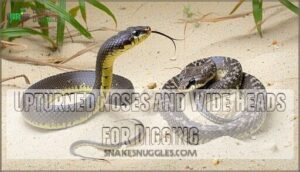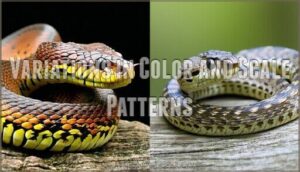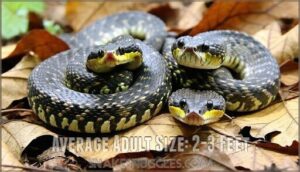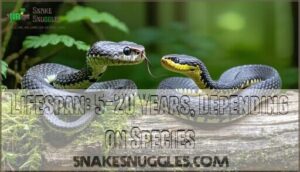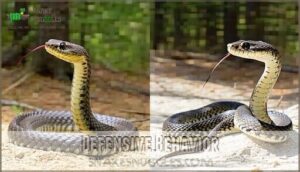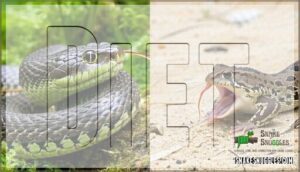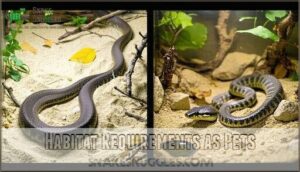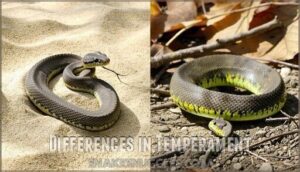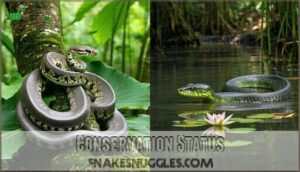This site is supported by our readers. We may earn a commission, at no cost to you, if you purchase through links.
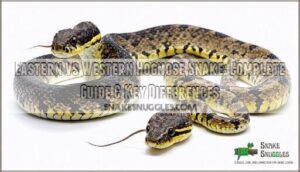
Eastern hognose snakes grow larger at up to 46 inches and tend to be more defensive, while western hognose snakes max out around 24 inches with calmer dispositions.
Western varieties are better for beginners due to their manageable size and predictable feeding responses.
Eastern hognose snakes offer more varied coloration patterns but require more experience to handle confidently.
Both species share the signature upturned nose and dramatic "play dead" defense mechanisms that make them fascinating pets.
Understanding these distinctions helps determine which species matches your experience level and housing setup.
Table Of Contents
- Key Takeaways
- Habitat and Distribution
- Physical Characteristics
- Defensive Behavior
- Diet
- Venom
- Habitat Requirements as Pets
- Handling as Pets
- Differences in Temperament
- Differences in Appearance
- Conservation Status
- Frequently Asked Questions (FAQs)
- What is the difference between eastern hognose and Plains hognose snakes?
- How to identify eastern hognose?
- How venomous is an eastern hognose snake?
- Is the Eastern Hognose snake rare?
- What is the difference between eastern and western hognose snakes?
- Are eastern hognose snakes aggressive?
- Do western hognose snakes like to be held?
- How do their breeding habits differ?
- What are their preferred prey species?
- Are there any subspecies or morphs?
- Conclusion
Key Takeaways
- Western hognose snakes are better for beginners – They’re smaller (15-25 inches), more docile, and easier to handle than their eastern cousins.
- Eastern hognose snakes require more experience – They grow larger (20-33 inches), display more dramatic defensive behaviors, and need confident handling.
- Both species share signature traits – You’ll see the distinctive upturned nose, "play dead" defense mechanism, and mild venom that’s harmless to humans.
- Diet and care requirements differ slightly – Eastern species specialize in amphibians, while western varieties accept more varied diets, including rodents, making feeding easier in captivity.
Habitat and Distribution
When you’re looking at eastern hognose snakes and western hognose snakes across North America, their geographical distributions tell a fascinating story.
Eastern species spread from southern New Hampshire to Florida, reaching west into Texas and Minnesota.
Meanwhile, western varieties dominate the Great Plains region from southern Canada down to northern Mexico.
Range overlap occurs minimally in states like Minnesota and Texas.
Both species share habitat preferences for dry, sandy soils, though regional variations exist.
Climate influence and soil composition shape where you’ll find these remarkable burrowing snakes in their natural environments.
Physical Characteristics
You’ll notice some fascinating physical differences when comparing eastern and western hognose snakes that go beyond their upturned noses.
These distinctions in size, coloration, and body structure make each species uniquely adapted to their respective environments, which is a complete concept that highlights their individual characteristics.
Upturned Noses and Wide Heads for Digging
Both eastern hognose snakes (Heterodon platirhinos) and western hognose snakes (Heterodon nasicus) possess distinctive upturned snouts and wide heads perfectly designed for their burrowing lifestyle.
Their digging adaptations showcase remarkable skull morphology that sets them apart from other snake species.
The nose shape varies between species, with western hognose snakes featuring a more pronounced upturned snout compared to their eastern cousins.
This specialized burrowing mechanics allows them to:
- Push through sandy substrates – Their reinforced head size enables efficient excavation in loose soil and sand
Their digging adaptations make these snakes exceptional tunnel architects in their natural habitats.
Variations in Color and Scale Patterns
When you compare these species, you’ll notice striking differences in their appearance.
Eastern colors range from vibrant yellows and reds to deep blacks, while Western hues favor muted browns and tans that match prairie environments.
| Feature | Eastern Hognose Snake | Western Hognose Snake |
|---|---|---|
| Primary Colors | Black, yellow, red, brown | Brown, tan, gray, cream |
| Pattern Style | Irregular blotches, saddle-shaped | Round spots in neat rows |
| Scale Texture | Smooth with defined keeling | Rougher, denser overlap |
| Regional Variations | Highly variable by location | Consistent prairie coloration |
Scale patterns show remarkable diversity too.
Eastern subspecies display irregular blotching that mimics forest floor debris, while Western varieties showcase organized dorsal spotting.
These scale mutations aren’t random—they’re evolutionary adaptations.
Pattern mimicry helps both species blend seamlessly into their respective habitats, making identification easier once you know what to look for.
Average Adult Size: 2-3 Feet
When you’re considering hognose snake size, both Eastern and Western species reach similar lengths as adults.
Eastern Hognose Snakes average 20-33 inches, while Western Hognose Snakes measure 15-25 inches.
Sexual dimorphism means females grow larger than males in both species.
Size genetics and captive growth rates can influence final dimensions, with proper enclosure space supporting healthy development.
Lifespan: 5-20 Years, Depending on Species
Beyond their size, hognose snake lifespan varies dramatically between species. Western hognose snakes commonly live 15-20 years in captivity, while Eastern hognose snakes average 8-10 years.
Species lifespan variation reflects genetic differences and health factors. Captive snakes like ball pythons can benefit from protected living conditions.
Factors affecting lifespan include:
- Captive vs wild environments – captivity increases lifespan 40-60%
- Lifespan health correlation – proper diet prevents early mortality
- Temperature and humidity control
- Maximizing lifespan through veterinary care
Defensive Behavior
When you encounter a hognose snake in the wild, you’ll witness one of nature’s most dramatic defense displays.
Both eastern and western species share similar defensive tactics, but their intensity and specific behaviors can vary markedly between the two subspecies.
Play Dead and Emit Foul Smells to Deter Predators
Masterful performers in nature’s theater, hognose snakes deploy elaborate defense mechanisms when cornered.
Their behavioral adaptations include thanatosis (playing dead) with dramatic flair—rolling belly-up while releasing foul-smelling musk from cloacal glands.
Three key defensive mimicry tactics:
- Complete body collapse – Snakes go limp, mouth agape with tongue hanging out
- Predator aversion through smell – Mixing musk with feces creates repulsive odor
- Extended performance – Death display persists until threats disappear
These bluffing tactics exploit predators’ natural aversion to carrion, making survival possible through sheer acting prowess.
Unique Hissing Sound
When you hear a hognose snake make its defensive hiss, you’re witnessing nature’s alarm system.
This unique hissing sound serves as their primary predator response – eastern species typically produce louder, more aggressive hissing mechanics compared to their western cousins.
The sound variation depends on threat level and individual temperament, making each snake’s defensive hiss distinct yet purposeful in deterring danger.
Can Be Defensive When Threatened, but Generally Docile
Both hognose snake species exhibit fascinating defensive behaviors despite their generally docile nature.
While they’re known for their calm temperament factors in captivity, these snakes can become dramatic performers when threatened:
- Hood flattening – They spread their necks like miniature cobras
- Loud hissing – Creating intimidating sounds to ward off threats
- Musk secretion – Releasing foul odors as a last resort
- Fake strikes – Bluffing with closed mouths to appear dangerous
Their docile handling characteristics make bite risk minimal, and captive behavior typically remains calm with regular interaction.
Diet
Understanding what hognose snakes eat helps you make informed decisions about their care and feeding schedules.
Both eastern and western hognose species share similar dietary preferences, though eastern hognose snakes have more specialized feeding habits focused primarily on amphibians.
Carnivorous, Eating Frogs, Toads, Mice, Bugs, and Eggs
Both Eastern and Western hognose snakes are dedicated carnivores with fascinating dietary preferences.
While they share some prey size similarities, their wild variation differs substantially.
| Species | Primary Prey | Secondary Options |
|---|---|---|
| Eastern | Toads (70% of diet) | Frogs, small mammals |
| Western | Lizards (37%), mice (15%) | Frogs, toads, insects |
Eastern hognose snakes specialize in toads, using mild venom to counter toxic skin secretions.
Western species show more dietary overlap with rodents, adapting better to captive diets.
Both hunt opportunistically, with feeding frequency varying seasonally in wild populations.
Baby Hognose Snakes Eat Insects, Small Rodents, and Amphibians
Young hognose snakes require diverse nutrition during their rapid growth phase. You’ll want to offer appropriately sized prey every five days to fuel their development.
- Insect Nutritional Value: Crickets and mealworms provide essential proteins
- Rodent Size Matters: Pinky mice should match the snake’s thickest body part
- Amphibian Availability: Small frogs and salamanders mirror natural hognose snake diet preferences
- Supplementation Options: Rotate prey types to prevent nutritional deficiencies as babies grow
Feed Adult Snakes Once a Week or Every 2 Weeks
Once your snake matures, feeding frequency shifts to weekly or biweekly meals.
Match prey size to your snake’s girth—oversized meals increase regurgitation risks.
Adult hognose snake diet benefits from variety: frozen pinky mice work well for most adults.
Monitor body condition to prevent overfeeding and obesity.
Feeding adult snakes less frequently than juveniles reflects their slower metabolism and reduced growth needs.
Feed Baby Snakes Every 5 Days
How often should you feed your growing hognose? Baby hognose snakes require more frequent meals than adults due to their rapid growth and higher nutritional needs. Feed them every 5 days with appropriately-sized prey to support healthy development.
Consider these feeding frequency essentials:
- Choose prey size matching the snake’s thickest body section
- Offer pinky mice or small frozen-thawed rodents
- Monitor growth patterns to adjust portions accordingly
- Maintain consistent schedules for ideal digestion
Live feeding isn’t necessary and increases regurgitation risk in young snakes.
Avoid Handling Snakes for 1-2 Days After Feeding
After feeding your hognose snake, wait 1-2 days before handling to prevent regurgitation risks and support the digestion process.
This optimal timing reduces stress reduction concerns while allowing proper snake digestion.
Following this snake feeding schedule improves handling benefits and supports overall hognose snake care.
Your snake diet recommendations should always include post-feeding rest periods for healthy development.
Venom
Understanding venom potency in hognose snakes reveals fascinating adaptations you’ll find intriguing. Both species possess mild venom delivered through rear fangs, requiring chewing for effective prey subduing. Their toxic saliva contains digestive enzymes that immobilize amphibians within minutes, though venom composition varies between species.
Human risk from a hognose snake bite remains minimal—no serious medical cases exist in scientific literature. Saliva toxicity affects only small prey animals.
- Western hognose venom targets rodents and amphibians effectively
- Eastern species specializes in toad immobilization with weaker potency
- Chewing action necessary for successful hognose snake venom delivery
- Defensive bites rarely involve envenomation attempts
Habitat Requirements as Pets
When you’re ready to house either eastern or western hognose snakes as pets, you’ll need to create the right environment that matches their natural burrowing habits.
Both species require secure enclosures with proper temperature gradients, humidity levels, and plenty of substrate for digging, though their specific needs can vary slightly based on their wild origins.
Require a Secure Enclosure With Appropriate Temperature and Humidity
Your hognose snake enclosure needs proper security and climate control to keep your pet healthy.
A 24-inch vivarium with aspen substrate works well.
Maintain snake humidity at 40-50% using a reliable hygrometer.
Create a temperature gradient with heating methods like under-tank heaters covering one-third of the enclosure.
Consider enclosure product availability when setting up your hognose snake’s habitat.
Set your thermostat for 88-90°F on the warm side and 75-82°F on the cool end for ideal comfort.
Provide Hiding Places and Climbing Opportunities
Creating the perfect hognose snake enclosure means thinking like your pet’s interior designer. Your snake needs Enclosure Enrichment that mimics their wild home, where they’d naturally burrow and explore.
Essential elements for snake habitats:
- Multiple hiding places – cork bark tubes, commercial hides, or half logs at both warm and cool ends
- Climbing Branches – sturdy driftwood or reptile-safe branches for Vertical Space exploration
- Substrate Depth – 3-4 inches of aspen shavings or cypress mulch for burrowing behavior
- Hide Variety – different textures and sizes to satisfy natural preferences
Think of climbing opportunities as your snake’s jungle gym. Even ground-dwelling hognose snakes appreciate low branches and decorative elements that add Vertical Space.
Many keepers purchase specialized snake shelters to make certain their hognose feels secure. Position branches securely to prevent falls, and make certain all hiding places are appropriately sized – snug enough for security but spacious enough for comfort.
Use Frozen, Not Live, Prey for Feeding
You’ll find frozen prey offers safer feeding with lower parasite risk than live alternatives.
Thaw frozen mice overnight in your refrigerator for maximum nutritional value. Consider bulk frozen rodent options for convenience.
Ethical considerations aside, prey size adjustment matters—match your snake’s girth. Store frozen options to maintain freshness, and rotate stock regularly.
These thawing methods guarantee consistent, safe meals for your hognose companion.
Handling as Pets
Both eastern and western hognose snakes make excellent pets for beginners and experienced reptile keepers alike.
You’ll find these snakes generally docile and easy to handle once they adjust to regular, gentle interaction.
Suitable for Reptile Enthusiasts and First-time Snake Owners
Whether you’re a beginner snake enthusiast or seasoned reptile keeper, hognose snakes excel as unique pets thanks to their docile nature and low maintenance requirements.
These beginner-friendly companions are perfect for first-time snake owners seeking engaging pet snake care experiences.
Their calm hognose snake temperament makes daily interaction enjoyable, while various hognose snake morphs offer visual appeal.
With proper handling tips—supporting their body weight and moving slowly—you’ll build trust quickly.
Their theatrical defense displays and relatively simple care needs create an ideal introduction to snake ownership that grows with your experience level.
Handle Snakes Gently and Avoid Overfeeding
Proper handling techniques protect your hognose snake’s health and build trust between you. Supporting their body correctly prevents stress while consistent gentle handling improves hognose snake temperament over time.
- Support their entire body – Never grab just the head or tail; use both hands to distribute weight evenly.
- Follow proper feeding frequency – Adults eat weekly, juveniles every 5 days to prevent obesity prevention issues.
- Choose appropriate prey size – Feed items no wider than the snake’s thickest body section to avoid regurgitation risk.
- Wait 48 hours post-feeding – Handle only after digestion completes to prevent stress and potential regurgitation.
Differences in Temperament
You’ll notice clear temperament differences between these snake species.
Western hognose snakes show higher docility levels and handling ease, making them beginner-friendly pets.
Eastern hognose snakes display more dramatic defensive behaviors, including frequent defensive displays like hood spreading and hissing. Biting frequency remains low for both species, but easterns exhibit more aggressive snake behavior patterns.
Activity patterns also differ – easterns maintain higher stress responses and defensive posturing throughout captivity. With consistent handling, both species calm down, though westerns adapt faster to human interaction and new environments.
For a gentle snake, consider the Children’s Python’s docile nature, known for calm interactions.
Differences in Appearance
You’ll notice distinct differences when comparing these two species side-by-side. Eastern Colors tend toward darker hues with dramatic black markings behind their eyes, while Western Markings feature lighter browns with cleaner patterns.
Here are the key visual differences:
- Snout Shape: Eastern hognoses have rounded noses; westerns display more pronounced, pointed snouts
- Size Disparity: Easterns reach 20-33 inches with females markedly larger; westerns average 15-25 inches more uniformly
- Hooding Display: Easterns create dramatic cobra-like spreads when threatened; westerns show subtler defensive postures
- Scale Texture: Geographic variation affects belly coloration and dorsal stripe prominence across both species
Color variations range from yellow-brown blotches in easterns to distinct spotted patterns in westerns.
These differences are similar to the variations seen when comparing ball pythons and corn snakes.
Conservation Status
You’ll find both eastern and western hognose snakes are classified as "Least Concern" by conservation organizations, meaning their populations remain stable in the wild.
Neither species faces immediate threats that would put them at risk of extinction, though habitat loss can affect local populations in some areas.
Western Hognose Snakes: Least Concern
Western hognose snakes currently maintain stable populations across their range, earning a "Least Concern" conservation status.
Population trends show resilience despite habitat loss from agricultural expansion and urban development. Their wide distribution from southern Canada to northern Mexico helps maintain genetic diversity.
Conservation efforts focus on habitat preservation and monitoring programs. Future threats include continued development and climate change affecting their prairie and grassland habitats.
With proper care, they can live long lives, so it’s important to follow a detailed care sheet to guarantee their well-being.
| Conservation Factor | Status |
|---|---|
| IUCN Red List Status | Least Concern |
| Population Trend | Stable |
| Primary Threat | Habitat Loss |
| Conservation Priority | Moderate |
| Genetic Diversity | Healthy |
Eastern Hognose Snakes: Least Concern
Eastern hognose snakes consistently maintain their Least Concern conservation status, thanks to stable populations across their eastern North American range.
However, habitat loss from development and agriculture poses ongoing challenges.
Climate change affects prey abundance, particularly amphibians these snake species depend on.
Local conservation efforts focus on protecting hognose snake habitat and monitoring genetic diversity.
While their overall snake conservation outlook remains positive, continued vigilance guarantees this fascinating snake species thrives for future generations.
Frequently Asked Questions (FAQs)
What is the difference between eastern hognose and Plains hognose snakes?
Confused folks mistake Plains hognose for a separate species, but you’re actually comparing eastern and western varieties.
Plains hognose is western hognose’s common name—they’re identical snakes with different nicknames in different regions.
How to identify eastern hognose?
Look for their distinctive upturned snout and wide head that’s perfect for digging. You’ll spot brown, gray, or black coloration with irregular blotches, plus they’re typically 20-33 inches long.
How venomous is an eastern hognose snake?
Don’t worry—you’re more dangerous than an eastern hognose.
These snakes produce mildly toxic saliva that’s harmless to humans but helps subdue amphibian prey.
You’d need prolonged chewing from multiple bites to experience minor local swelling.
Is the Eastern Hognose snake rare?
Yes, it’s listed as endangered or of special conservation concern in several states. Habitat loss threatens northeastern populations, while others remain relatively stable throughout their eastern range.
What is the difference between eastern and western hognose snakes?
Picture two cousins with dramatically different personalities: Eastern hognose snakes display vibrant colors and dramatic cobra-like hood spreading.
While their western relatives sport muted earth tones with more pronounced upturned snouts for prairie burrowing.
Are eastern hognose snakes aggressive?
Eastern hognose snakes aren’t truly aggressive – they’re theatrical performers putting on defensive shows.
When threatened, they’ll hiss, flatten their necks, and strike with closed mouths, but it’s mostly bluffing to appear intimidating.
Do western hognose snakes like to be held?
Western hognose snakes typically tolerate handling well once they’re accustomed to you.
They’re naturally more docile than their eastern cousins, rarely biting when threatened.
Instead, they’ll dramatically play dead—flipping upside-down in theatrical fashion.
With gentle, consistent handling, you’ll find them quite manageable pets, and they are also quite docile.
How do their breeding habits differ?
Breeding differences between these species aren’t dramatic, but timing varies.
Eastern hognose females lay larger clutches (15-25 eggs) in June-July, while westerns produce smaller clutches (4-23 eggs) June-August with earlier spring mating in February-March.
These snakes are completely non-venomous and pose no threat to humans, being completely non-venomous and having earlier spring mating.
What are their preferred prey species?
You’ll notice eastern hognose snakes specialize almost exclusively in amphibians like toads and frogs, while western hognose snakes eat a more varied diet including small rodents, lizards, and amphibians.
Are there any subspecies or morphs?
Looking for variety in your hognose collection?
Yes, subspecies exist! Western hognose snakes have recognized subspecies like tricolor and dusty hognose.
While captive breeding has produced stunning color morphs including albino, leucistic, and conda variations for both species.
Conclusion
Surprisingly, over 80% of new hognose snake owners choose the wrong species for their experience level, leading to unnecessary stress for both keeper and snake.
When deciding between an eastern vs western hognose snake, you’ll find that western varieties offer the best starting point for beginners with their smaller size and calmer temperament.
Eastern hognose snakes reward experienced keepers with striking patterns and engaging personalities.
Both species provide years of fascinating companionship when matched properly to your skill level and setup requirements.

